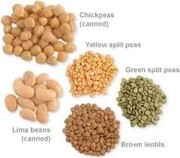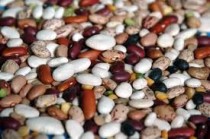Pages in this section:
1. Diabetes can be cured: probiotics
2. Curing diabetes using herbs, spices and dietary supplements
3. Curing diabetes: healthy oils
Diabetes sufferer switched to vegan diet, blood sugar stabilized after 10 days
Article from Natural news, Tuesday, February 19, 2013 by: Antonia
Eliminating meat and dairy, and including fruit smoothies and orange juice into the diet, has helped one woman normalize blood sugar levels. "I have diabetes and I was very worried that more carbs and fruit and less protein would mean my blood sugar would be harder to manage," said the senior member at Mothering.com.
Additionally, the woman reports increased energy, weight loss and improved digestion. Her body is rejecting some medications, and it appears it is handling her skin issues (scalp psoriasis, rash, acne, pimples) on it's own, albeit very aggressively.
Legumes lower blood pressure and improve blood sugar
A study that appeared in Online First by Archives of Internal Medicine involving 121 people with Type II diabetes, who were on anti-diabetic medication, split the group between those who increased legumes by at least one cup per day, and those who increased the amount of whole wheat foods.
The results of the study caused the authors to support the consumption of legumes. "Legume consumption of approximately 190 grams per day (one cup) seems to contribute usefully to a low-GI diet and reduce CHD risk through a reduction in BP," said David J.A. Jenkins, MD, of the University of Toronto and St. Michael's Hospital.
Eating raw nuts can stave off diabetes, as well as heart disease
Many dieters begin to consume more nuts as they switch to more of a raw food and/or vegan diet. As it turns out, this could be a leading factor in the numerous studies showing improved symptoms for diabetics who choose the vegan lifestyle. "Adding one ounce of mixed nuts to the diet daily can help reduce obesity, blood pressure, and blood sugar that are all markers of metabolic syndrome that can lead to Type II diabetes and heart disease," said Kathleen Blanchard, RN, reporter for eMaxHealth.
Blanchard adds, "nuts are also packed with antioxidants to support overall health and reduce inflammation that accompanies chronic diseases like diabetes."
Many health researchers say it is more about what you take away, than what you add, to the diet, that can improve health. But as the member of Mothering.com points out, "more carbs and fruit" did not have any negative effects on her blood sugar levels, when some medical personnel might suggest the opposite as being true.
More Legumes for Better Diabetes Control
This study was published in a recent issue of the Archives of Internal Medicine. The study was partially funded by the Saskatchewan Pulse Growers, a nonprofit organization representing legume growers in Canada.
If you have type 2 diabetes, you probably already know that you need to keep a close eye on what you eat. Certain foods can affect how well you manage your condition. A recent study suggests people with diabetes should try adding more legumes to their diet. Researchers found that eating more of them may lower blood sugar and blood pressure levels.
Legumes are foods that include beans, lentils, and chickpeas. Such foods are naturally high in protein and fiber - two components that may boost heart health. Legumes are also rated low on the glycemic index, which measures the amount of sugar in a food. Eating foods on the low end of the index may help control diabetes better. "Legumes, which we always thought were good for the heart, actually are good for the heart in ways we didn't expect," says lead researcher David Jenkins, M.D., at the University of Toronto. Among people with diabetes, "not only did their glucose control become better, but - and this surprised us - it had a significant effect on blood pressure."
For the study, researchers had 121 people eat either 1 cup of legumes or 1 cup of whole-wheat foods a day. After about three months, researchers noted both groups saw a drop in blood sugar and blood pressure levels. But those eating legumes had the most improvement in both levels.
Experts stress that people with diabetes should focus on a healthy diet. Legumes can certainly play a part in that, even if you can't eat a cup a day. Other studies have suggested that legumes can lower the risk for type 2 diabetes, cardiovascular disease, and even cancer. "Legumes will do well for you," says Dr. Jenkins. "They will help you keep your blood pressure down and your blood glucose under control. They can help you keep your cholesterol down, too."
Increase your fiber intake: http://www.naturalnews.com/042051_fiber_diabetes_healthy_diet.html
Global Diabetes Epidemic Caused by Obesity
Articles at mercola.com
The global diabetes epidemic continues to worsen because of the increasing rate of obesity in many countries worldwide.
http://articles.mercola.com/sites/articles/archive/2011/12/05/global-diabetes-epidemic-rages-on.aspx
Apple cider vinegar shows promise against diabetes complications
Article from NaturalNews by Sandeep Godiyal
September 11, 2013
A pilot study on the effect that apple cider vinegar (ACV) has on gastric emptying rate revealed glycemic control problems with type 1 diabetics, but it is otherwise effective in reducing levels
of postprandial glucose and insulin among healthy people. However, Swedish researchers Joanna Hiebowicz, Gassan Darwiche, and Ola Biorgell, who were involved in the pilot study, did not regard the
findings as a setback in either diabetes research or the quest for more therapeutic benefits from apple cider vinegar.
Media even reported heightened public interest in the numerous health benefits of ACV owing to promising results from other similar studies. This came about as a team of five scientists offered
experimental evidence that ACV provided satisfactory lipid profile among both normal and diabetes-induced rat subjects. Lead researcher Anahita Mansouri is optimistic that their findings will
contribute to the global efforts to manage complications arising from diabetes in the near future.
A flashback to 400 BC medicine
ACV practically vanished into oblivion when vinegar was mass-produced, refined and subjected to pasteurization and distillation processes. However, now that interest in this vinegar is renewed,
the scientific and medical communities have their hopes high that ACV has not lost its vaunted healing abilities after being frozen in grandma's cellar for centuries. After all, it was the father of
medicine himself, Hippocrates, who endorsed ACV as a healing elixir and cleansing agent in 400 BC.
The good old ACV was used by Hippocrates both as an antibiotic and antiseptic to treat his patients. This was long before Alexander Fleming and Joseph Lister entered the scene and patented their
rediscovered products from mold and tar, respectively. Through the years, however, the use of ACV was propagated through folk medicine and doctors who believe in its therapeutic efficacy.
Nutritional composition and health benefits of apple cider vinegar
The following nutrients are found in ACV in trace amounts: calcium, copper, fluorine, iron, magnesium, phosphorus, potassium, silicon and sulfur. There are also claims that ACV contains some vitamins. Here is a partial list of the numerous health benefits of apple cider vinegar:
- Aids in both weight loss and weight gain
- Combats calluses, corns and warts
- Destroys bacteria, germs, mold and viruses
- Detoxifies cells and organs from deleterious bodily waste products
- Enhances insulin sensitivity and metabolism
- Fights infection and osteoporosis
- Helps block carbohydrates
- Prevents food poisoning
- Promotes digestion
- Reduces cholesterol levels
- Regulates blood pressure
- Relieves arthritis pain, chronic fatigue, headache, laryngitis, sore throat, etc.
- Restores vitality to dry and damaged skin from sunburn and other skin problems
Wrapping it up, a natural remedy like apple cider vinegar should be better than medications made from synthetic chemicals. Indeed, with the health benefits of ACV, an apple each day can keep the doctor away. Additionally, it pays to remember not to sway away from the cider to keep your health and wellness in check
Studies show that reishi mushrooms fight cancer and diabetes
Article from Natural news by Michael Ravensthorpe
December 29, 2013
Reishi mushrooms have been used to treat countless ailments in the Far East for over 2,000 years. They are especially venerated in their native China, where they have acquired the nickname "The
Mushrooms of Immortality" due to their extraordinary medicinal properties. Indeed, long-term consumption of reishi mushrooms - which are characterized by their red, kidney-shaped cap and their tough,
"woody" texture - has been linked to reduced blood pressure, improved nerve function, enhanced stamina, weight loss and much more.
Two conditions that reishi mushrooms seem to particularly excel at treating, however, are cancer and diabetes - two of the most serious and common diseases in the United States today. Below is a
collection of studies that prove their effectiveness at combating these diseases.
Reishi and cancer
According to Drs. Joann Lau and Sanda Zolj, two research scientists at Bellarmine University, reishi mushrooms contain important polysaccharides and saponins that decrease cell proliferation in
cancerous lungs. The researchers discovered that this effect was due to apoptosis ("cell death") instigated by the mushroom's active compounds. They concluded that "detailed biochemical
characterization of this ancient herbal remedy could hold tremendous promise for the treatment of lung cancer."
Lau and Zolj's research is reinforced by that of Dr. Teow Sun Soo at the MARA Institute of Technology in Malaysia. Soo, determined to understand the effects of reishi on various ailments, conducted clinical
trials that required subjects to take reishi extracts at regular intervals. Soo found not only that the extract boosted the body's immune system to fight cancer but that it could also reduce the
harmful side effects of radiation therapy and chemotherapy. Soo admitted, however, that the results depended on the type of cancer and the severity of the condition. For treating cancer, Soo recommended taking six 500
milligram capsules, three times daily.
Reishi and diabetes
According to researchers from the Institute of Vascular Medicine at the Chinese University of Hong Kong, reishi mushrooms can lower blood sugar levels in laboratory animals. For their study, which
was published in the May 2009 edition of Phytomedicine, the researchers fed 0.03 and 0.3g/kg of reishi extracts to diabetic mice over a one-month period. The extracts lowered the blood
glucose levels of the mice within a single week, leading the researchers to believe that the mushroom inhibits an enzyme used by the liver to produce glucose.
Another Chinese study, which was conducted by researchers at the Department of Pharmacology of Peking University in Beijing and published in the December 2006 issue of the Journal of Asian
Natural Products Research, specifically looked into reishi's effects on diabetic kidney disease. After the eight-week trial period, the diabetic subjects exhibited noticeably reduced markers of
kidney stress, as well as lowered triglyceride and blood sugar levels. The researchers concluded that reishi mushrooms can prevent or halt the progression of diabetic kidney complications.
Important: Unlike most other medicinal mushrooms, which can be eaten cooked, reishi have a tough texture that is difficult for our stomachs to digest. Therefore, if you're interested in utilizing reishi as a medicine, consider consuming it in extract form (like in the studies) for improved nutrient absorption.
Anti-Diabetic Effects Found in Citrus Foods and Juices
Written By Case Adams, Naturopath
September 25th 2012
Researchers from China's State Agriculture Ministry and Zhejiang University have determined that two ingredients commonly found in many citrus fruits, naringin and neohesperidin, will effectively reduce blood sugar. The study tested the two citrus constituents using human liver cells. The scientists found that the two natural compounds increase the uptake of glucose among the cells.
This study confirms previous research that pointed to the possibility that these citrus constituents may be helpful for reduce blood sugar for those with or at risk for type 2 diabetes and suffer from poor glucose control and/or heightened glucose tolerance. Other research has found these compounds also regulate liver enzymes phosphoenolpyruvate carboxykinase and glucose-6-phosphatase - helping glucose uptake regulation and increasing liver efficiency. The researchers extracted the two flavonoids from the Chinese citrus fruit called Huyou (Citrus changshanensis). This citrus, as well as others such as grapefruit and related species - has been used as an anti-diabetic agent in Traditional Chinese Medicine, Ayurveda and other traditional Asian medicines.
The naringin and neohesperidin compounds were found throughout the fruit part of the citrus, including the juice sacs and the segments. Another Chinese study found that the Huyou peel contained the highest naringin and neohesperidin content. Several other citrus fruits contain naringin and neohesperidin. This doesn't mean that orange juice necessarily contains naringin and neohesperidin. A 2000 study from the Citrus Research and Education Center tested a number of orange juices using liquid chromatography. The analysis found that the two 100% orange juice samples tested contained neither naringin nor neohesperidin. However, juice samples that contained orange juice together with small amounts of grapefruit juice, sour orange (Citrus aurantium) juice and K-Early citrus juice did contain naringin and neohesperidin.
Other research has determined that the common sweet orange (Citrus sinensis) will typically contain naringin, but very small amounts, and will typically not contain neohesperidin. Sour oranges
(Citrus aurantium) – especially when picked early, will contain considerable amounts of naringin and neohesperidin. Mandarin oranges (Citrus Reticulata) are also good sources for both naringin and
neohesperidin. Grapefruit contains naringin and neohesperidin, but its neohesperidin content is typically smaller. Lemons and limes typically do not contain either compound in lieu of their
hesperidin content, but a few species – such as the Bergamot - will contain naringin and possibly small amounts of neohesperidin.
In addition to its anti-diabetic
properties, naringen has been found in laboratory studies to be neuro-protective. It appears to protect against the effects of 3-nitropropionic acid, which has been found
to be one of the primary agents that produce nerve damage in Huntington's disease and other nerve disorders.
Low sugar diet
This is actually really good news, don't miss this article from Natural news by Sandeep Godiyal
February 15, 2013
"One of the most common myths associated with diabetes is that too much intake of sugary foods triggers it. It should be noted; however, that while a low-sugar diet can help reduce the chances of dealing with diabetes, the excessive consumption of sugar is not the sole cause of it.
There are other factors that tend to affect health and trigger the condition. But everyone is still advised to stick to a diet with less sugar since it can help prevent obesity, which is one of
the most common triggers of the disease.
Understanding the real relationship between sugar and diabetes
Sugar (sucrose) which is believed to be the leading cause of diabetes is a type of carbohydrate which naturally occurs in food. It comes in numerous types differentiated by the number of molasses
that stay on the crystal. Among its different types are white sugar, icing sugar, caster sugar, golden syrup and honey. Its main connection to diabetes is that the disease refers to a condition
wherein the body is incapable of effectively using glucose. It is a type of sugar so it is no longer surprising to see people who often get confused as to the safest amount of sugar that they should
consume on a daily basis.
Note; however, that sugar and diabetes are indirectly connected. What the increased consumption of sugar does is increase the risk of putting on too much weight or suffering from obesity. Being
overweight or obese is recognized by experts as one of the main culprits of the disease so taking in too much sugar which can add to a person's weight is not good for those who wish to avoid diabetes
as much as possible.
It is also important to note that certain studies fail to produce reliable evidences that directly link sugar and diabetes. Still, the ability of foods that contain it such as cakes, cookies, candies
and sodas to make a person's blood sugar level rise and their weight go up, can increase the chances of suffering from the disease.
Although there is no scientific evidence that directly associate sugar with diabetes, it is still advisable for those who wish to avoid the disease to stick to a low sugar diet by making sure that
their intake of sugary foods are done in moderation. This is a huge help for anyone who wishes to maintain a healthy weight to reduce the risk of getting the disease. Eating foods that are low in
sugar can also help sufferers of the disease who need to strictly follow a healthy eating plan which involves proper carbohydrate counting and intake. It works in controlling diabetes and preventing
the condition from becoming worse. (SO GO ON SOME WATER ONLY FASTS, GET YOUR GUT FLORA RIGHT, AND EAT RIGHT WITH SOME GOOD SUPPLEMENTS. ENJOY A LITTLE HONEY OR SUCANAT OCCASIONALLY. TH)
Diet fizzy drinks make you 60% MORE likely to get diabetes than regular, 'full fat' versions. Drinking one can a week of any type of fizzy drink increases risk of diabetes by a third. Women who
drank 1.5 litres of diet drinks a week had up to 60 per cent increased risk of the disease Artificial sweeteners in diet drinks may be to blame PUBLISHED: 2/8/13
Women who drank diet drinks were more likely to develop diabetes than those who indulged in a regular, full-sugar version. Diet fizzy drinks can raise the risk of diabetes by 60 per cent, startling
new research has revealed. A study of more than 66,000 women found those who drank artificially sweetened drinks were more likely to develop the disease than those who indulged in regular, 'full fat'
versions.
The findings, published in the American Journal of Clinical Nutrition, fly in the face of conventional thinking that regular versions of fizzy drinks are always worse for our health. The effect is
compounded by the fact that diet drinkers also consume more - on average 2.8 glasses a week compared to 1.6 for regular drinkers. Regular, full-fat versions of fizzy drinks have previously been
linked to an increased risk of diabetes. But less is known about their artificially sweetened counterparts - often promoted as a healthier substitute. In the study, more than 66,000 middle-aged
French women were quizzed about their dietary habits. Their health was then monitored over 14 years from 1993 to 2007.
Heavy drinking is killing people in their 20s and 30s, warns top liver specialist How much caffeine is too much? The Starbucks coffee with 'three quarters of the safe daily dose' in one cup The
researchers, from the National Institute of Health and Medical Research in France, examined the rates of diabetes among women who drank either regular or diet fizzy drinks and those who drank only
unsweetened fruit juice. Women who drank fizzy drinks had a higher risk of diabetes than those who only consumed juice. Those who drank up to 359ml of any type of fizzy a week - just more than a
regular-sized can - were a third more likely to develop the disease. The risk was more than double in those who drank 600ml a week - just bigger than a regular bottle. Drinkers of diet drinks had an
even higher risk of diabetes compared to those who drank regular ones.
Those who drank up to 500ml a week had a 15 per cent increased risk. Once more than 1.5 litres a week was consumed, this became a 60 per cent increased risk. 'Contrary to conventional thinking, the
risk of diabetes is higher with "light" beverages compared with "regular" sweetened drinks,' the researchers said. The paper noted previous research which had showed that aspartame - the most wisely
used artificial sweetener - has a similar effect on blood glucose and insulin levels as the sucrose used in regular sweeteners.
World Health Organisation statistics show that 347 million people worldwide have diabetes, a chronic disease which occurs when the pancreas does not produce enough glucose-controlling insulin, or
when the body cannot efficiently use it. Over time, the disease can damage the heart, blood vessels, eyes, kidneys, and nerves - increasing the risk of heart disease, kidney failure, stroke and
blindness."
10 foods to prevent and stop diabetes
Article from Natural news, Thursday, October 10, 2013 by: Yanjun
Diabetes is a disorder wherein the body cannot control its level of blood glucose or sugar. While many of the foods today contain high levels of diabetes-inducing sugar, there are ten amazingly healthy foods that can actually prevent diabetes from developing. Not only do these foods control blood sugar levels, but they are also packed with other nutrients and minerals that even those who do not have diabetes will benefit greatly from.
A healthy diet coupled with a healthy lifestyle of exercise to maintain a normal weight is a sure-fire way to prevent diabetes type 2 or adult-onset diabetes. This is according to research as well as diabetes educators from the Healthcare and Education for the American Diabetes Association (ADA). Christine Tobin, the president of Healthcare and Education for the ADA, said that, while there are a whole list of foods that can be considered as "superfoods" in terms of diabetes-prevention, her association recognizes the top ten of these foods that can help those with both type 1 and type 2 diabetes. These foods contain vitamins and minerals such as calcium, magnesium, potassium and vitamins A, C and E. These foods are also rich in fiber, which helps in suppressing cravings by keeping the blood sugar and the glycemic index low for longer periods. On top of that, these foods also control blood cholesterol and blood pressure levels, keeping them at healthy levels.
These are all very important to those with diabetes, but even normal people can benefit from these foods too:
- Beans: Black, pinto, navy, kidney or other beans might be high in calories, but they are also rich in fiber and other nutrients. Rich in fiber means that they will help people feel full for longer periods.
- Dark, Leafy Greens: Spinach, mustard greens, collard greens, kale and others are not only high in nutrients but also low in carbohydrates. Greens are also very low in calories, so people can eat as much of them as they as want!
- Citruses: Grapefruit, oranges, lemons and other citrus fruits are good for the heart because of their high content of vitamin C. Whole fruits are better than juices, since the fruit contains the fiber, which slows down the body's absorption of sugar.
- Sweet Potatoes are better than other types of potatoes, because they have a low glycemic index. This means that sweet potatoes will not cause blood sugar levels to spike. They are also high in vitamin A.
- Berries: Fresh, whole strawberries, blueberries, cranberries and any other variants are rich in vitamins, antioxidants and fiber. Add fresh berries into salads or cereal, or make into smoothies.
- Tomatoes can be eaten either raw or cooked, and they are low in calories too. They can be served in a variety of ways, as side dishes, mixed in salads and soups or as a base sauce for casseroles or stews. Tomatoes are rich in vitamins E and C and iron.
- Fish: Salmon, mackerel, albacore tuna, herring and halibut are all rich in omega-3, a kind of fatty acid that strengthens the heart and prevents diabetes. The best way to enjoy these fishes and their benefits is to serve them broiled or in soups. Frying them in batter and breading defeats the purpose.
- Whole Grains: Oatmeal, pearled barley and other whole grain products, like bread and pasta, all contain high amounts of fiber. They also contain essential nutrients like chromium, magnesium, omega-3 and folate.
- Nuts are high in omega-3 and other good fatty acids. These kinds of fats protect and help the heart rather than burden it. However, one should not eat too much, as they are high in calories. A small handful, or roughly 1.5 ounces, is enough for a healthy snack.
- Fat-Free Yogurt and Milk: Both are rich in calcium and vitamin D and are also good choices to help keep cravings under control.
It is quite easy to lose control and to splurge on food, but a good choice would be to splurge on these ten healthy foods rather than on sweets like chocolate.
Mediterranean diet may be best for diabetes
Article by Kathryn Doyle | Reuters
"Diets lean on meat and rich in healthy fats like olive oil were most effective at promoting weight loss and lowering blood sugar among people with diabetes in a review of evidence from the last 10
years. Benefits were also seen with diets low in carbohydrates, high in protein or low in simple sugars.
"If you look at different types of diets, these four can improve various aspects of diabetes control," lead author Dr. Olubukola Ajala, a diabetes specialist at Western Sussex Hospitals in the UK,
told Reuters Health. More than 24 million Americans have type 2 diabetes. People with the disease cannot store glucose in their cells effectively, and their blood sugar levels can go dangerously
high. Lifestyle changes like weight loss and cutting calorie intake can improve blood sugar control and reduce the risk of complications from the disease, but it has not been clear which diet plans
work best.
Ajala and her colleagues reviewed the results of 20 studies comparing the effect of seven popular diets on adults with type 2 diabetes. Mediterranean diets, low-carb diets, high-protein diets and low
glycemic index diets - which rank foods by how quickly their carbs turn into glucose - all lowered participants' blood sugar. After following the diet for at least six months, the people on a
Mediterranean eating plan also lost an average of 4 pounds. No other diet had a significant impact on weight, according to the findings published in the American Journal of Clinical Nutrition.
"We were quite surprised by the Mediterranean diet in particular," Ajala said. "I would have thought that low-carb would have been the best for losing weight, but Mediterranean seems to be better. A
Mediterranean-style diet emphasizes fruits, vegetables and legumes, whole grains, fish, and using olive oil and herbs in place of butter and salt. Saturated fats from red meat and dairy products are
typically less than eight percent of total calories consumed.
Other studies have linked Mediterranean diets with reduced risks of cancer, Alzheimer's disease, Parkinson's disease and death from heart attack (see Reuters Health story of November 25, 2011: http://reut.rs/vkSAAP).
Though the review found no evidence that vegetarian, vegan or high-fiber diets aided in weight loss, they might still have promise for improving blood sugar control, the report notes. In addition, low-carb, low-glycemic and Mediterranean diets all led to increases in markers of heart health - "good" cholesterol rose by 4 percent to 10 percent, and triglycerides fell by up to 9 percent. The authors caution that the study could not tease apart the beneficial effects of weight loss - versus the types of foods consumed - in the results seen with some of the diets. "One has to take this with a pinch of salt," Ajala said. "Weight loss is important, but so is nutrient quality," Katherine Zeratsky, a registered dietician at the Mayo Clinic in Rochester, Minnesota, told Reuters Health.
Portion control and sustainability are the most important elements of a diet plan for type 2 diabetes, according to Zeratsky, who was not involved in the study. She thinks Mediterranean diets may
be more successful because they are easier to maintain than restrictive low-carb or high-protein diets. "I think we're all still recovering from that low-fat diet phase of the 1990s," Zeratsky said.
Olive oil makes food more palatable and satisfying, and may curb the urge to snack later in the day, she added.
But a Mediterranean diet is not the only way to achieve weight loss and improve heart health, Zeratsky said. It's more important to take a balanced approach, including fruits and vegetables, eating
moderate portions and talking to a doctor before embarking on a plan. "It's not just about dumping olive oil on a salad," Zeratsky said.
Diabetes remission possible with revised diet and excercise
Article by Genevra Pittman, Reuters health Tue, Dec 18, 2012
One in nine people with diabetes saw their blood sugar levels dip back to a normal or "pre-diabetes" level after a year on an intensive diet and exercise program, in a new study. Complete
remission of type 2 diabetes is still very rare, researchers said. But they added that the new study can give people with the disease hope that through lifestyle changes, they could end up getting
off medication and likely lowering their risk of diabetes-related complications. "Kind of a long-term assumption really is that once you have diabetes there's no turning back on it, and there's no
remission or cure," said Edward Gregg, the lead author on the report from the Centers for Disease Control and Prevention.
The research, he told Reuters Health, "is a reminder that adopting a healthy diet, physically-active lifestyle and reducing and maintaining a healthy weight is going to help manage people's diabetes
better." His team's study can't prove the experimental program - which included weekly group and individual counseling for six months, followed by less frequent visits - was directly responsible for
blood sugar improvements. The original goal of the research was to look at whether that intervention lowered participants' risk of heart disease (so far, it hasn't). But the diabetes improvements are
in line with better weight loss and fitness among people in the program versus those in a comparison group who only went to a few annual counseling sessions, Gregg's team reported Tuesday in the
Journal of the American Medical Association.
Is it cost effective?
About eight percent of people in the United States have diabetes, according to the American Diabetes Association. The new study included 4,503 of them who were also overweight or obese. People
randomly assigned to the intensive program had diet and exercise counseling with a goal of cutting eating and drinking back to 1200 to 1800 calories per day and increasing physical activity to just
under three hours per week.
After one year, 11.5 percent of them had at least partial diabetes remission, meaning that without medication their blood sugar levels were no longer above the diabetes threshold. That compared to
just two percent of participants in the non-intervention group who saw their diabetes improve significantly. People who'd had diabetes for fewer years were more likely to have blood sugar
improvements, as were those who lost more weight or had stronger fitness gains during the study. However, less than one-third of people whose diabetes went into remission during the program managed
to keep their blood sugar levels down for at least four years, the researchers found. "Clearly lifestyle intervention is good for people with diabetes," said Dr. John Buse, a diabetes researcher from
the University of North Carolina at Chapel Hill School of Medicine. "The question is how cost-effective is it, what are the long-term consequences (and) how would it really compare with alternative
approaches like bariatric surgery and drug therapy?" Buse, who wasn't involved in the new study, told Reuters Health.
Dr. David Arterburn, from Group Health Research Institute in Seattle, said some studies of weight-loss surgery, for instance, have found two-thirds of people who start out with diabetes have complete remission. Arterburn, who co-wrote an editorial published with the new study, said anyone with diabetes - or at high risk - should consider either lifestyle interventions or surgery, if they're eligible, to reduce future health risks.
Gregg said his team was working on a cost-analysis of the current program, but that it was fairly "resource-intensive." "If people have access to the support to make these sorts of changes, they may have the benefits that we've seen here," he said. But, "What we should remember is that more modest changes in lifestyle are also effective."
Processed milk linked to diabetes
Article from Natural news Saturday, December 08, 2012 by Joseph Bova
"We all grew up with the classical food pyramid, consuming all the proper servings of grains, dairy, and meat. Well, what if you found out that one of the main levels of the food pyramid actually
could give you diabetes? Studies have indeed shown that our bodies, when reacting to A1 beta-casein in dairy, cause a diabetes-like response.
The facts
Diabetes is one of the most prevalent conditions in the western world. According to the American Diabetes Association, 18.8 million people are currently diagnosed with diabetes in the United States,
seven million people are currently undiagnosed and 79 million people are classified as "pre-diabetic." For decades, people who have developed Type I diabetes have been told that there is nothing they
can do about it, that they were just "born" that way. However, studies have been done which show significantly strong evidence that auto-antibody reactions against the A1 beta-casein particles in
cows' milk, may contribute to beta cell (pancreas) dysfunction and Type I diabetes.
The correlation has been shown through multiple studies worldwide. The prevalence of casein consumption and diabetes diagnoses are very closely related. The suspected manner in which this occurs
is through what is known as cross reactivity (micro-mimicry). Cross reactivity is when our bodies attack a foreign agent such as casein, as well as a cell type in our body. What happens is as we
consume dairy products, our body has to digest the food. It breaks the dairy down into both whey and casein proteins. In cross reactivity or micro-mimicry reactions, the body attacks the casein
molecule as a foreign invader, and it also begins to attack beta cells in the pancreas because they look very similar. The reaction is similar to a guy taking a girl out on a date, and the next time
he goes to take her on the date, he actually takes her twin sister out. The two particles may act and look the same but obviously, we know they are not the same. Unfortunately, when the body's immune
system is in "attack" mode, it sometimes gets "a little carried away." As stated by Cavallo et al (1996), it is suggested that micro-mimicry may take place between a sequence of the beta-casein
protein and an epitope of the GLUT 2 transporter. This means when the body attacks the casein molecule, it will also attack the GLUT 2 transporter dealing with glucose regulation.
Think about the type of diet an average American has in 2012. If you take the high inflammatory diet that Americans have and add these micro-mimicry reactions, you can see why autoimmune disease is
such a problem today. If you read the data from 1975 until 2010 in regards to dairy consumption per year, you will see an increase of 77 pounds per capita. This is a significant increase considering
we have more knowledge of food now than we did in 1975.
So, does this mean that casein is the only cause of diabetes, no. It does mean; however, that before you give your kid a nice tall glass of cows' milk, think about the future repercussions. You are
not giving your child diabetes, but you are increasing their chance of developing this disease. Now, there are many alternative options that are very delicious and healthy. In fact, options such as
coconut milk or almond milk actually have many benefits. Now you have the information, it is up to you to choose not to be ignorant and make changes.
The above article is just one small reason we only drink raw milk in our family, thank God for it! (TH)
Long water fasting and diabetes
LONG WATER ONLY FAST FOR TYPE 1 DIABETES IS VERY EFFECTIVE:
Type I diabetes, Mellitus by definition, is the result of the destruction of the Beta-cells in the Islets of the pancreas. These cells \"measure\" blood sugar and secrete Insulin
accordingly. Insulin then \"drives\" the \"insulin receptors\" on our other cells.. these are little \"pumps\" that move blood sugar from the
surroundings into the cells. The word Insulin is derived from Islets.. small \"islands\" of Beta-cells scattered among the pancreas tissues.
Thus, according to the strict definition of Type I DM, it is incurable. We cannot produce new Beta cells. At least this has never been demonstrated. However, I have witnessed on the odd occasion Type
I DM reversing during a longish fast. This was however almost exclusively very shortly after the diagnosis. The islet cells were therefore not totally dead yet, only damaged and therefore unable to
produce insulin. During a fast we do not need insulin, as most of the body runs on Ketones, and the bit of sugar that is formed from fat, can be consumed by the heart and the brain, the two organs
capable of ingesting blood sugar without the aid of insulin. Theoretically during this \"holiday\" for the Beta-cells, they may repair themselves before they die.. but then we have
to address the original \"cause\" of their being damaged.
Thus:
1. I try to prolong this; by administering Insulin at full replacement dosages for a few days, even weeks, after the patient has started eating.
2. I always suggest a purely vegan diet afterwards. This is because animal products might contain proteins similar to those on the beta cells, which could have triggered the immune response
originally responsible for the damage.
NOW I SAY, PLEASE NOTICE IN THE ABOVE ARTICLE, IN A WATER ONLY FAST THE BODY DOES NOT NEED INSULIN, IT RUNS ON KETONES... IF MORE OF US WOULD FAST MORE OFTEN AND NOT BE AFRAID TO GO ON A 1, 2, OR 3 WEEK FAST WE WOULD SEE ALOT MORE PEOPLE HEALED OF THEIR DISEASES! OF COURSE THE BIGGEST DANGER IS IN PEOPLE BREAKING THEIR FAST WRONG, TOO FAST, OR ON THE WRONG THINGS.. YOU MUST BREAK A LONG WATER ONLY FAST PROPERLYAND YOUR BODY CAN HEAL ITSELF OF ALMOST ANYTHING, WITH GOD'S BLESSING -TH
See more about fasting here
Daily fasting and timing of meals can prevent diabetes and obesity
Article from Natural news, Tuesday, September 11, 2012 by: John Phillip
Ancient wisdom posits that calories in equal calories out when trying to lose weight and prevent disease. There is a wealth of new scientific research to suggest that all calories are not the same
when metabolized through digestion, and more importantly the timing of meals as well as the time between each meal may hold the key to obesity and the incidence of diabetes. Calorie-restricted
mammals and humans show a food-energy dependent extension in lifespan, and new evidence demonstrates that regular eating times and extending the daily fasting period may override the adverse health
effects of a high-fat diet and prevent obesity.
Researchers from the Salk Institute for Biological Studies have published the result of a study with mice in the journal Cell Metabolism. The scientists examined the effect of limiting food intake to
eight hours each day and compared disease progression with a similar group of mice that were allowed to eat as they desired throughout the day (ad libitum or ad lib). All mice consumed the same
number of calories and high fat content. The study was designed to determine whether obesity and metabolic diseases result from a high-fat diet or from disruption of metabolic cycles.
Researchers find that daily fasting for sixteen hours prevents weight gain and diabetes progression Senior study author, Dr. Satchidananda Panda commented "It's a dogma that a high-fat diet leads to
obesity and that we should eat frequently when we are awake... our findings suggest that regular eating times and fasting for a significant number of hours a day might be beneficial to our health."
Prior studies have implicated regular grazing throughout the day with increased incidence of metabolic syndrome and related diseases including diabetes, as blood sugar levels remain elevated for long
periods of time and never fully return to fasting levels.
To conduct this study, researchers fed two groups of mice that shared the same genes, gender, and age, an unhealthy diet comprised of 60 percent of its calories from fat. One group could eat whenever
they chose and consumed more than half their calories at night, while nibbling throughout the day. The second group was restricted to eating for only eight hours per day with a required sixteen hour
mini-fast each day.
After a period of 100 days, the mice that ate a fatty, ad libitum diet throughout the day gained weight and developed high cholesterol, high blood glucose, liver damage and diminished motor control.
The mice subjected to a 16-hour fast each day weighed 28 percent less than the ad lib group and showed no adverse health effects despite consuming the same amount of calories from the same fatty
food. The study team concluded "that fasting time is important. By eating in a time-restricted fashion, you can still resist the damaging effects of a high-fat diet, and we did not find any adverse
effects of time-restricted eating when eating healthy food."
Nutrition scientists are rapidly coming to the conclusion that there are many more intricate components to overweight, obesity, and chronic disease than calories consumed and macronutrient content.
Try limiting meals to an eight hour period each day to improve digestive hormone balance (leptin and ghrelin) and dramatically improve biometrics associated with obesity and metabolic disease
Check these articles out too:
http://articles.mercola.com/sites/articles/archive/2011/12/05/global-diabetes-epidemic-rages-on.aspx
Global Diabetes Epidemic Caused by Obesity articles.mercola.com
The global diabetes epidemic continues to worsen because of the increasing rate of obesity in many countries worldwide.
Four powerful ways to reverse diabetes
Article from Natural news, Tuesday, November 29, 2011 by: Celeste M. Smucker, MPH, PhD
There are many benefits to finding ways to reverse diabetes. A big one is its expense. According to the American Diabetes Association, the combined cost of medical care and lost productivity due to
diabetes in the United States exceeded $174 billion in 2007. People with diabetes pay 2.3 times as much for health care as non-diabetics, and $1 in every $10 spent for health care is attributable to
diabetes. Once diabetes was largely considered a disease of adults, but today so many children receive this diagnosis it is no longer referred to as adult onset. Fortunately, given the pervasiveness
and expense of diabetes, there are cost effective holistic remedies, which could make an important contribution towards its reversal, thus avoiding a great deal of pain and suffering and saving a lot
of money.
Conventional approaches to treating diabetes include diet and medication to control insulin and blood sugar levels. Unfortunately, medication comes with side effects such as blindness, loss of limbs,
heart disease, stroke, and kidney disease - all of which are costly in their own right. An alternative is a holistic approach such as that of Robert O. Young, PhD, known for his work establishing the
importance of a healthy pH balance for diabetes treatment.
In his approach to diabetes Dr. Young suggests it is not so much a disease of the cells as it is a condition created by the environment of the cells. His conclusions are based on a study of
participants in his program, designed to improve pH balance through emphasis on alkalizing foods, exercise and use of supplements beneficial for diabetes. Alkalizing foods include most vegetables,
certain fruits such as lemons, grapefruits, tomatoes and avocados, some nuts, especially almonds, and green tea. Acid foods, on the other hand include sugar, alcohol, coffee and wheat flour products
as well as most protein sources such as meat and dairy. Everyone, who stayed with Dr. Young's program for a full three months, either enjoyed a significant reduction in their need for insulin or were
able to discontinue it all together. Many also lost weight and had lower blood pressure and cholesterol.
The importance of diet in diabetes was also supported by a study reported in the August, 2011 edition of the American Journal of Clinical Nutrition. There researchers examined longitudinal data and
concluded that reducing intake of red meat can have a significant impact on diabetes. Although they were not concerned with acid/alkaline balance, the fact that red meat is relatively acid may help
in part to explain their results.
Other holistic solutions for diabetes include adaptogenic herbs such as Tulsi or holy basil. Tulsi, which is highly valued in India, is used by Ayurvedic practitioners for many conditions including
diabetes. Its use has been validated by studies; in one 40 individuals with non-insulin dependent diabetes took 2.5 grams of dried tulsi powder every morning. The result was significantly lower blood
sugar both first thing in the morning and after meals. Tulsi also helped lower cholesterol levels. Cinnamon is yet another herb which has many applications and is effective for diabetes. A recent
study in Pakistan followed 30 individuals who took cinnamon for 40 days. At the end of this time tests showed significant reductions in blood sugar, triglycerides and cholesterol.
(The above article is why I take cinnamon capsules most each day, and I don't even have diabetes, thank God (bought an inexpensive capsule making machine on Amazon and make my own, buying bulk from Amazon TH)
Wheat may promote diabetes
Written By Sayer Ji, founder, posted on Monday, November 18th 2013
While it is not a commonly understood concept that wheat or gluten can cause blood sugar disorders, and certainly not as serious as type 1 diabetes, which involves the autoimmune destruction of the insulin producing beta cells in the pancreas, a sizable body of animal and human data points to exactly this causal link.
Gluten, after all, is well known for adversely affecting gut health, and in the case of celiac disease, destroying the absorptive surface of the intestine through a hallmark autoimmune triggered process. In many ways, gluten opens up a 'pandora's box' of autoimmunity by both triggering intestinal permeability – so-called 'leaky gut' – as well as providing over 23,000 unique, digestion resistant polypeptides which are capable of infiltrating the body causing systemic inflammation and the loss of immunological self-tolerance, i.e. the ability to distinguish self from non-self. Adding to this increasingly dismal picture of what was once considered the ultimate poster child for 'healthy food,' a new study published in the PloS One may have uncovered a 'missing' link in understanding how wheat exerts its toxic effects.
Mayo Clinic researchers sought to elucidate the mechanism at play within the long observed link in both animal and human studies between dietary gluten and the pathogenesis of type 1 diabetes (T1D), focusing on the role of the gut microflora in mediating its diabetes promoting properties. In the new study titled, "Low Incidence of Spontaneous Type 1 Diabetes in Non-Obese Diabetic Mice Raised on Gluten-Free Diets Is Associated with Changes in the Intestinal Microbiome",[ii] they sought to confirm "whether changes in the intestinal microbiome could be attributed to the pro- and anti-diabetogenic effects of gluten-containing and gluten-free diets, respectively." They noted recent research showing that intestinal microflora have a major influence on the incidence of T1D, and theorized that since "diet is known to shape the composition of the intestinal microbiome," they might find an important link by testing changes in the gut flora of animals fed either gluten or gluten-free diets.
The study design was described as follows: "NOD [non-obese diabetic] mice were raised on gluten-containing chows (GCC) or gluten-free chows (GFC). The incidence of diabetes was determined by monitoring blood glucose levels biweekly using a glucometer. Intestinal microbiome composition was analyzed by sequencing 16S rRNA amplicons derived from fecal samples."
The researchers observed the following results: "First of all, GCC-fed [gluten-containing chow fed] NOD mice had the expected high incidence of hyperglycemia [elevated blood sugar] whereas NOD mice fed with a GFC [gluten-free chows] had significantly reduced incidence of hyperglycemia. "Secondly, when the fecal microbiomes were compared, Bifidobacterium, Tannerella, and Barnesiella species were increased (p = 0.03, 0.02, and 0.02, respectively) in the microbiome of GCC [gluten-containing chow fed] mice, where as Akkermansia species was increased (p = 0.02) in the intestinal microbiomes of NOD [non-obese diabetic] mice fed GFC [gluten-free chows]. "Thirdly, both of the gluten-free chows that were evaluated, either egg white based (EW-GFC) or casein based (C-GFC), significantly reduced the incidence of hyperglycemia."
The researchers found that when they added back gluten to the gluten-free diet group the following occurred:
- Diabetic symptoms returned
- Akkermansia species were reduced
- Bifidobacterium, Tannerella, and Barnesiella increased
According to the study, these observed changes suggest "that the presence of gluten is directly responsible for the pro-diabetogenic effects of diets and it determines the gut microflora." They observed a gluten free "diabetes inhibitory" diet resulted in altering the non-obese diabetic mice's microflora to reflect a "richer" bacterial profile. Conversely, they observed that a gluten-containing diet resulted decreases in a genus of gastrointestinal microbiotia (Akkermansia) previously shown to protect against the development of type 1 diabetes. Since the immune system develops and its function is maintained in large part through its relationship with the microflora in our gut, it makes sense that gluten's promotion of autoimmune disorders, which include celiac disease and type 1 diabetes to name but a few, could be connected to the way this complex of proteins adversely affects the diversity of gastrointestinal microflora. The researchers concluded: "Our novel study thus suggests that dietary glutencould modulate the incidence of T1D [type 1 diabetes] by changing the gut microbiome."
This new study follows closely in the wake of another recent PloS study that found the alcohol soluble portion of gluten known as gliadin promotes weight gain and pancreatic beta cell hyperactivity – a potential contributor to type 2 diabetes (marked by excessive and/or elevated insulin) and a precursor to type 1 diabetes. Given the increasingly dense body of research indicating wheat has diabetogenic properties the time has come to recognize that many of the most common ailments that afflict our species today are a direct result of the consumption of popular foods such as wheat, which are mistakenly believed to be safe and wholesome.


















